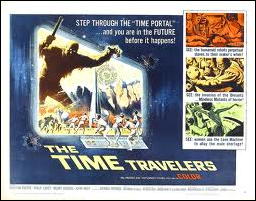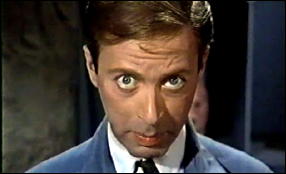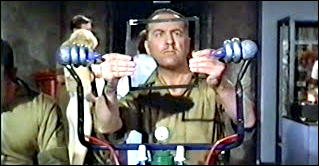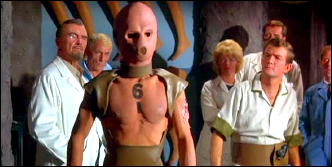Sat 21 Jun 2014
A Movie Review by Jonathan Lewis: THE TIME TRAVELERS (1964).
Posted by Steve under Reviews , SF & Fantasy films[9] Comments
THE TIME TRAVELERS. American International, 1964. Preston Foster, Philip Carey, Merry Anders, John Hoyt, Dennis Patrick, Joan Woodbury, Delores Wells, Steve Franken, Berry Kroeger. Screenwriter/director: Ib Melchior.
The Time Travelers is a science fiction B-movie starring an assortment of character actors who were likely familiar to movie audiences at the time of its initial release, but who are less well remembered today.
Although considerably dated in many ways, The Time Travelers remains a fun, albeit somewhat campy, low budget film about the possibilities and hazards of time travel. The film likewise provides a glimpse into an era before television shows such as Star Trek and Doctor Who brought these concepts to a wider audience.
It begins with two scientists, a Teutonic-looking Dr. Erik von Steiner (Preston Foster) and Dr. Steve Connors (Philip Carey), along with their blonde female assistant, Carol White (Merry Anders), working in a Los Angeles university laboratory. What separates their workspace from others like it is a large window on the far end of the room. This window is designed to be the means by which the scientists, should their experiment work, can observe the future.
Along comes a goofy technician named Danny McKee (Steve Franken, cousin to U.S. Senator Al Franken), who tells the scientists to end their experiment.
It’s all too little, too late, of course. Something goes wrong. The group inadvertently creates not just a window, but also a portal, to the future. 2071 A.D., to be exact. (107 years forward from 1964). Suffice it to say, the future looks bleak. That, of course, doesn’t stop McKee from jumping through the portal into the foreboding landscape. The other three follow.
Earth 2071 A.D. isn’t a particularly nice place to live. That’s the understatement of the year. A nuclear war has decimated the planet, leaving horrifying, mutant humanoids at ground level and a very small number of normal humans dwelling below ground.
The underground human survivors are led by Dr. Varno, portrayed by John Hoyt wearing what appears to be a light blue jump suit of some sort. The colorful costumes, it should be noted, are just one of many aspects that make the film very much a product of the mid-1960s.
In any case, Varno, along with the other survivors and an extremely creepy array of androids, are working on a plan to fly a spaceship to Alpha Centauri so as to build New Earth. Naturally, they plan to be in a state of suspended animation along the way. (It’s a long trip, after all.) Initially, the plan is for the stranded time travelers to accompany the survivors out beyond the stars.
But, alas, that is not to be. A malicious politician, Councilman Willard (Dennis Patrick), ends that idea, forcing the four time travelers to rebuild their time machine. After a genuinely unsettling fight scene between mutants and androids, the four time travelers, along with Varno and others, end up returning to 1960s California, only to experience one of the paradoxes of time travel.
It’s actually a clever little twist ending, one that I admittedly didn’t see coming. More significantly, it demonstrates that the filmmakers took science fiction tropes seriously. More to that point: well-known sci-fi guru Forrest J Ackerman makes a very brief cameo appearance.
The Time Travelers may neither be a classic, nor a great film. But it’s far better than many other low budget science fiction of its time and significantly better than a lot of the science fiction cinema out there today. The movie definitely has its moments, such as when Dr. Varno states: “Time, itself, is an anachronism.â€
Silly at times, it’s worth watching, provided you know full well that you’re watching a B-movie designed to entertain rather than to provoke serious reflection and debate.





June 22nd, 2014 at 5:00 am
I saw this film once, many years ago. Most of the fine detail has gone from my memory, but I do remember the climax of the story very distinctly. It’s probably one of the first cinematic treatments of time travel to actually use the idea of time paradoxes as part of the plot (it’s interesting that the second BACK TO THE FUTURE movie is generally the least popular of the three because it really does go into the mechanics of time travel–time travel gives a lot of people headaches). Overall I remember it as a fun little movie, although rather on par with a made for TV movie.
There is a sort of metafictional element to this nowadays, whether the makers intended or not. The characters watch a screen on which events from another time play out. It’s always 1964 on the other sided of the screen.
June 22nd, 2014 at 9:08 am
Bradstreet,
Given that time travel paradoxes are one of my favorite SF gimmicks, maybe I’ll have to watch the movie after all. I saw only bits and pieces as Jon was watching, not enough to trigger my interest until I read his review and your comment.
June 22nd, 2014 at 8:26 am
Preston Foster could add a certain conviction to just about anything he did, from homicidal maniac in DR.X to Oakhurst in OUTCASTS OF POKER FLAT, to LAST DAYS OF POMPEII, P-I Bill Crane in THE WESTLAND CASE, and on to fine westerns like I SHOT JESSE JAMES, THUNDERHOOF and RAMROD.
June 22nd, 2014 at 9:05 am
Foster also played Captain Pat Chambers in I, THE JURY. But I remember him the most as Cap’n John Herrick in the TV series WATERFRONT. We had just gotten a TV set back then, 1954 or so, and it was the show we enjoyed the most — out of a very limited selection available to us in an isolated section of northern Michigan (lower peninsula).
June 22nd, 2014 at 12:16 pm
Preston Foster was excellent in this. I still don’t know exactly what to make of John Hoyt’s role. I’d be curious to know what other people think.
The filmmakers definitely did make use of the time travel paradox as part of the plot and for that they should be commended. They did, in my opinion, miss an opportunity to flesh out the dynamics of the post-nuclear war society of Earth 2071 A.D. Who are the mutants? Who are the underground ‘normal’ humans? I thought they missed a chance here.
June 23rd, 2014 at 11:28 am
This movie sounds like fun and I’m a sucker for time travel stories anyway. I just ordered from amazon the Movies For U edition for $5.
June 23rd, 2014 at 12:15 pm
That’s the version I watched it on: the Movies for You
August 24th, 2017 at 8:10 am
Now featured on the new MST3K! I actually enjoyed the movie more than the commentary. I thought some of the special effects were quite clever in a low-budget way.
February 8th, 2018 at 12:39 pm
Just watched it and was going to post a review, but you said everything I as gonna –Nice job!